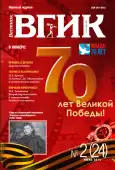Eisenstein’s Aesthetics in Semiotic Perspective
- Authors: Khrenov N.A.1
-
Affiliations:
- State Institute of Art Studies
- Issue: Vol 7, No 2 (2015)
- Pages: 8-19
- Section: THEORY AND HISTORY OF CINEMA | AUDIOVISUAL ARTS
- URL: https://journals.eco-vector.com/2074-0832/article/view/14784
- DOI: https://doi.org/10.17816/VGIK728-19
- ID: 14784
Cite item
Full Text
Abstract
The article is devoted to the semiotic interpretation of the theoretic heritage of the film director Sergey Eisenstein by Vyacheslav Ivanov whose jubilee has been recently celebrated. Sergey Eisenstein foresaw the structural methodology that became so popular after the 60s. Vyacheslav Ivanov is known for his vast range of academic interests. The present article is focused on his interest in cinema, in particular - the theoretic heritage of Eisenstein. This interest may be explained by Vyacheslav Ivanov’s assertion, that Eisenstein tended to see cinema as a language or, more specifically, a sign system. This fact couldn’t escape Vyacheslav Ivanov’s notice, since the formation of semiotic methodology in Russia is closely connected with Eisenstein. So it is quite natural that Vyacheslav Ivanov reflects on the prehistory of semiotics too. As for cinema, prehistory in question is closely connected with Sergey Eisenstein’s aesthetics. The author of the present article also touches upon applying semiotic methodology to cinema as a sign system in general. Due to this purpose, the author refers to the period, when Russian cinema theorists were involved in semiological analysis introduced with the influence of structuralist and post-modernist studies in humanities. Some theoreticians attacked semiotic approaches in favor of philosophical and, in particular, phenomenological one. Nevertheless though these approaches are appropriate and efficient, they do not replace the semiotic one. The author argues, that such attempts to refuse from the semiotic approach in the cinema field were ill-timed and superficial. Vyacheslav Ivanov’s semiotic works on cinema, especially his book Eisenstein’s Aesthetics, simultaneously affirm a philosophical approach to this topic. Interpreting the meaning of the title, the author of the present article argues, that the concept of semiotics was already created at the initial stage of the development of aesthetics as a branch of philosophy.
About the authors
Nikolai Andreyevich Khrenov
State Institute of Art Studies
Author for correspondence.
Email: editor@vestnik-vgik.com
PhD in Philosophy, professor, Deputy Director
References
- Бердяев Н. Судьба России. Опыты по психологии войны и национальности. - М., 1918.
- Иванов В. Эстетика Эйзенштейна // Иванов Вяч. Вс. Избранные труды по семиотике и истории культуры, т. 1. - М.: Школа «Языки русской культуры», 1968.
- Лотман Ю. Проблема «обучения культуре» как ее типологическая характеристика // Труды по знаковым системам. Выпуск 5. - Тарту, 1971.
- Мотрошилова Н.С. Франк и Н. Бердяев о «новом варварстве» // Культура и форма. - М., 2010.
- Паперный В. Культура Два. - М., 1996.
- Федотов Г. Судьба и грехи России. Избранные статьи по философии русской истории и культуры, т. 2. - СПб., 1992.
- Ханзен-Леве О. Русский формализм. Методологическая реконструкция развития на основе принципа остранения. - М., 2001.
- Эйзенштейн С. Метод, т. 1. Grundproblem. - М., 2002.
- Эйзенштейн С. Метод, т. 2. Тайны мастеров. - М., 2002.
- Эйзенштейн С. Избранные произведения: в 6 т., т. 4. - М., 1966.
- Эйхенбаум Б. Теория «формального метода» // Эстетика и теория искусства ХХ века. Хрестоматия. Ответственные редакторы Н. Хренов, А. Мигунов, - М.: Прогресс- Традиция, 2007.
- Якобсон Р. Формальная школа и современное русское литературоведение. - М., 2011.
- Якобсон Р. Новейшая русская поэзия. Набросок первый. Подступы к Хлебникову // Якобсон Р. Работы по поэтике. - М., 1987.
Supplementary files








